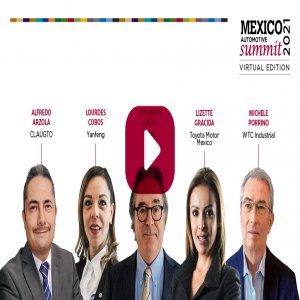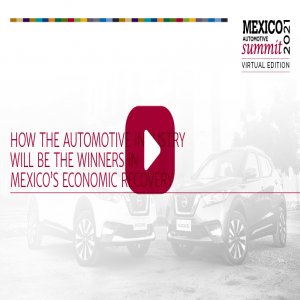
Incentives, Infrastructure Needed to Advance Heavy Vehicle Trends
 By Cas Biekmann | Journalist and Industry Analyst -
Wed, 03/24/2021 - 12:29
By Cas Biekmann | Journalist and Industry Analyst -
Wed, 03/24/2021 - 12:29
You can watch the video of this panel here.
Lower costs, better management and higher sustainability in heavy vehicles are already within grasp, said panelists during Mexico Automotive Summit’s first panel on Wednesday, Mar. 24. However, infrastructure needs to catch up. Further government incentives and enhanced financing options are also needed to spur growth and help Mexico renew its vehicle fleet. Miguel Elizalde, President of ANPACT and moderator of the panel, asked a variety of questions to Alejandro Mondragón, CEO of SCANIA; Flavio Rivera, CEO of Daimler Vehículos Comerciales México; Marcelo Caraveo, Risk Director and Asset Manager of TIP and Frank Gudlach, Director General of Man Truck & Bus, regarding the biggest trends in the sector.
“Mexico is the fourth exporter and sixth producer of heavy vehicles in the world,” began Elizalde. But the country has taken a hit, just like every other country in the world, as a result of the pandemic. This meant 31.4 percent export cuts during 2020, with another drop in early 2021. “We hope that an economic reactivation in the US improves the situation,” said Elizalde. Rivera noted that “an interesting boost” was indeed already visible in that market.
Despite the challenges, Mondragón noted that countries like Mexico had a lot to gain if companies renewed their vehicle fleet. Even though every separate crisis is different, the concept is always similar. “We are in a country where the currency is exposed to fluctuations,” he added. Especially in Mexico, companies would therefore need to establish a business model that takes the potential of these fluctuations into account. Gundlach agreed with Mondragon, noting that older vehicles are often inefficient, which generates higher costs, he said. “The concept of total cost of ownership (TCO) is especially important. Maintenance and resale value, as well as fuel consumption are crucial,” continued Mondragón, noting that there is a large Mexican market of around 400,00 old units that are pending renovation. But to make this happen, companies must address different challenges.
“In 2020, companies were more careful to preserve their liquidity and fleet renovation was not a priority,” Caraveo outlined. Financing options are currently somewhat limited, as well, further preventing renovations. In this regard, support in the form of incentives from the government and a greater effort from all companies involved are needed. With new options on the table in terms of financing and greater incentives, the sector can overcome its aging fleet issues, said Caraveo.
Among the benefits of adopting new heavy vehicles is the greater technological advancements they can offer, panelists firmly agreed. Gundlach sees digitalization as especially interesting. “Digitalization has a lot to do with connectivity,” he explained. Through telematics and digital solutions, companies can monitor their trucks and busses easily, improving performance and lowering costs and consumption at the same time. Operating costs can drop as far as 30 percent by adequately implementing technology, Gundlach noted. “These new technologies can help fleet managers to make decisions on the spot,” concurred Caraveo.
Mondragón noted the importance of the information technology provides to companies. “The availability of information we have these days was only a dream 15 years ago,” he said. Now, companies can manage a digital twin of every truck and bus, monitoring temperature, pressure and speed. This helps to improve and maintain vehicles. Furthermore, Mondragón said SCANIA uses this information to incentivize clients and their drivers to operate more efficiently by rating drivers with a grade going from A to D. The information can be used to improve performance, which is incentivized by lower payments per kilometer. Dynamic maintenance plans, instead of traditional fixed plans based on kilometers, become a possibility as well.
Rivera explained that there are three main pillars for heavy vehicles in the transport industry: sustainability, safety and connectivity, which often overlap. Planning, maintenance and adequate fleet management are crucial to reduce costs. But the technology that helps make this happen needs a fundamental basis. “Technology’s foundations lay in infrastructure. We need road, communication and fuel infrastructure, first,” he said. Mexico faces a great challenge in this regard. Rivera explains that the vehicles produced are already quite advanced, allowing for companies to meet strict environmental guidelines such as SEMARNAT’s NOM-044. But the country’s infrastructure to provide cleaner fuels is lacking at times. “Only 78 percent of the country has the infrastructure to supply ultra-low sulfur diesel,” Rivera said. Mexico needs to still take steps to improve access to cleaner fuels, compressed natural gas and electrical charging stations. “The technologies are already here but it is a matter of costs, as well. I do not think Mexico will remain behind within this global reality,” added Gundlach. The cost of new vehicles is a main barrier as well, Caraveo reminded the audience.
“In Mexico, it necessary to first make the use of sustainable fuel mandatory and then launch the technology,” argued Elizalde. Nevertheless, much can be gained if Mexico is incentivized to clean up its transport. “The potential to move transportation toward greener technologies will have a massive impact on the environment,” Mondragón said.
















